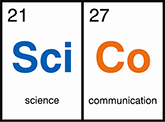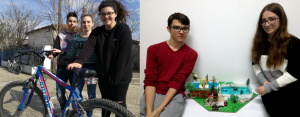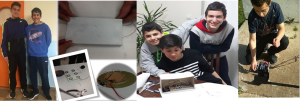STEMpowering Youth : Students projects of the second cycle
The "STEMpowering Youth" program is implemented in 15 provincial towns since February of 2017, and aims at student empowerment on science topics, with the use of new technologies. In each round of the program, the students are trained with interactive educational tools on Natural Sciences, Astronomy and Programming topics, and they participate in experiential activities and group projects, making constructions.
At the end of each course round, each team creates its own project. Within their project, the students have the opportunity to do research and manufacture a construction in order to resolve a real-life issue of the local society, thereby learning the steps that a researcher/scientist have to take for the implementation of an idea. The projects made by our small inventors during the second round of STEMpowering Youth can be seen below.
In Xanthi, three students created "Smart Finder", an Arduino-based construction aiming at tracking individuals that suffer from dementia via GPS. If an elder citizen gets lost, the device enables the dispatch of an SMS notification to the family, to inform them on his/her precise location. Another student invented an Arduino-based plastic bottle lid counter, that counts the lids and displays the number of lids inserted on a screen, whilst also computing the remaining number of lids needed for the purchase of a wheelchair, thus encouraging her schoolmates to gather more plastic lids.
Ardu-Masters in Xanthi decided to create an Arduino-based safety alarm, that is placed on the door and produces a sound when sensing somebody entering the room, until the user types in the correct password through the connected keyboard. All means of transport are equipped with direction indicators, except from the bicycle. To address this issue, a group of three students invented a biker jacket with Arduino that has two luminous arrows sewed in the back, which illuminate when the biker wants to make a turn.
In Orestiada, the fog is a usual phenomenon, and a group of four students wanted to contribute to the safety of the city residents by equipping their bicycles with fog lamps. The automated Arduino-based device is placed under the saddle of the bicycle, and gathers data through light and humidity sensors, in order to automatically activate the fog lamps when it is humid or dark. Another frequent phenomenon in Northern Greece are the floods of Evros, Ardas and Erythropotamos rivers. For this issue, a group of three students suggested the use of an automated anti-flood dam with Arduino. The children made a scale model of a river and placed sensors in the river bank to measure the water level. A level increase activates the engines that open and close the door of the dam, in order to prevent the flood.
Didymoteicho is built at the confluence of Ebros and Erythropotamos rivers, and the valley is often flooded, resulting in damages in cultures, houses and livestock farms. Four students invented the "Water Level Controller", an Arduino-based construction that measures the water level and notifies the user via a dedicated smartphone App, in the case of an abnormal level increase. Four students wanted to help farmers in their area via the creation of "AgroSensor", an Arduino-based device that takes measurements via multiple sensors (temperature, humidity, carbon monoxide and precipitation), and notifies immediately the farmer via a dedicated smartphone App in the case of fire or flood. The younger students of the class built an impressive 4x4x4 Led cube with Arduino, and programmed it to blink its lights in various visual patterns, to serve as disco party lights for the school celebrations!
In Komotini, three students created an Arduino-based device that reads special cards for electronic door unlocking in buildings accessed daily by many individuals, such as hospitals and companies. The device has three lamps: a blue one indicating that it is ready for scanning, a green one indicating that the card-holder has been granted access, and a red one indicating that access is not permitted with this card. Two students constructed a robotic school assistant, a vehicle that functions with Arduino and follows a black line that connects the secretariat with their classroom, equipped with a basket mounted on the roof for the transport of various objects. The teacher can exchange messages with the secretariat and get markers, chalks, the attendance registry and whatever else may be needed during class.
Recently, the bridge on the road connecting Iasmos with Komotini fell apart, and vehicles pass through the nearest Irish Crossing that is covered by a thin layer of water, as it crosses the river. Three students created an illuminated warning sign, which uses data collected by an Arduino device measuring the water level and indicates the depth of the water, in order to help the drivers decide whether they will pass through the crossing.
Another group of three students built a bicycle alarm which works with two Arduino devices, a transmitter and a receiver. The transmitter is tucked under the saddle of the bicycle and detects motion in the area sending data to the receiver, who notifies the user by audiovisual means (light and sound) when the bicycle is removed. Three students invented an optimal sleep assistant, an Arduino-based device that checks the conditions of the surrounding environment to ensure a restful sleep, that is to say 20°C temperature, low brightness and quietness. Their device checks these conditions with appropriate sensors, and it turns on a green light when the temperature is not optimal, a red light when there are loud noises and a blue one when the room is too bright.
In Kos, two students envision a city where the citizens will walk and their steps will “produce” electric energy! Inspired from the nature of energy-not being destructed, but changing forms instead-, they invented piezoelectric tiles for energy production. The tile is constituted by wooden plates and piezoelectric capsules that convert the dynamic energy from each step to electric, which will in turn be used to power the street lights etc.
Three students wanted to help people with special needs and they made an Arduino-based device for handicap parking spots, which detects any car entering the spot and sets off a buzzer. The handicap vehicle owners can obtain a password that they will type in the device keyboard, so as to stop the warning sound.
The commercially available mowers are quite costly. Two students built a rechargeable mower from reusable materials that they collected from warehouses and garages.
In Kalymnos, not all streets are properly lighted. A group of three students made a biker jacket with direction indicators in the back, using Arduino Lilypad that can be sawn in fabrics. The girls sewed special led lights in the shape of left and right arrows, which are activated by a switch located in the corresponding sleeve. What happens when a snake or a scorpion stings a climber, or when a fisherman needs an insulin shot? Three students constructed a hospital drone that has special sheath for the fast transport of medical materials such as gauzes, shots and special directives, thereby providing a new aspect of direct medical help.
A student was inspired by the inextricably linked life of Kalymnos residents with the sea and invented a hydrobot with Arduino. The submarine takes measurements related to the water temperature, depth and oxygen content, and he intends to add an underwater camera to aid searches for sponges, since Kalymnos is famous for its sponge fishers! Diving can damage the human body, with Diver's disease (decompression sickness) being the most known complication. Three students were inspired to make a "Diver's watch" which is equipped with a sounder, a manometer, a heart rate monitor and a GPS indicating that the exact location of the diver if something goes wrong.
In Rhodes two students made "Senior S.O.S" in order to help elderly individuals that suffer from cardiac disease or Altzheimer's. The watch they invented monitors cardiac function, body temperature and tracks the location of the user with GPS. The device dispatches an SMS if the measurements are worrying, and a family member of the user can be notified through a dedicated smartphone App made by the students.
Three students wanted to make an automatic feeder for strays in their town. Each time an animal approaches, special servomotors are activated to open a door in order to drop food in the container placed underneath. Two of their schoolmates created an automatic feeder and water dispenser for strays or pets. Each time an animal approaches at a distance less than 20 cm, the device is activated and a door opens to drop food and a water pump fills a second container.
In the end of this round the "Agro Sensor", "Luminous plate", "Hospital Drone" and "Senior S.O.S" constructions were awarded as the best ones of STEMpowering Youth second round, providing the opportunity to the students to participate in the competition for a travel in CERN in the summer of 2018.
 English
English Ελληνικα
Ελληνικα







Comments are closed.